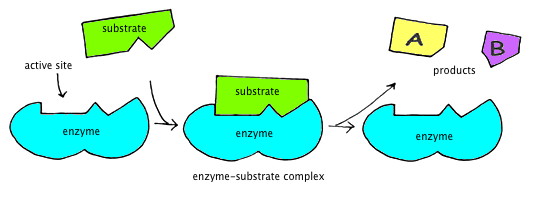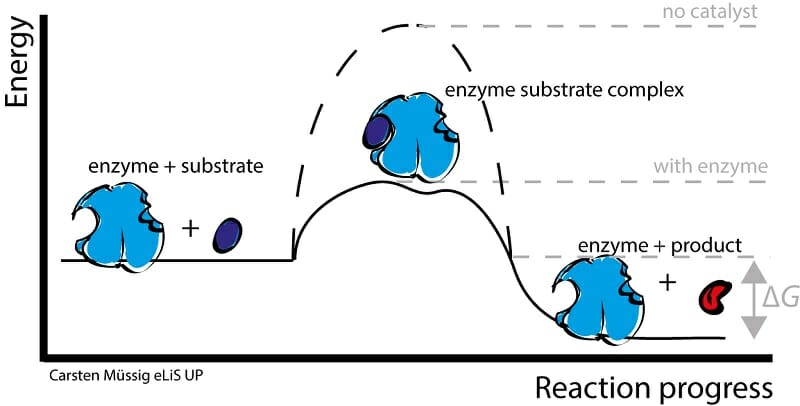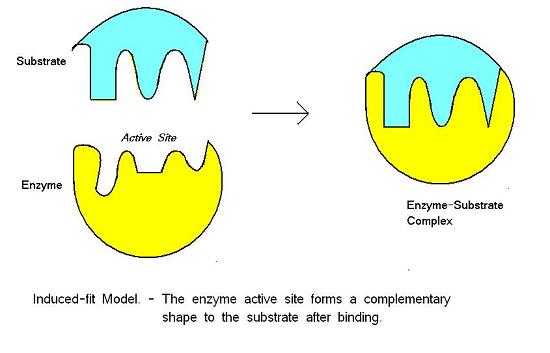Explain the Different Parts of an Enzyme Substrate Complex
This is the most accepted of the theories of enzyme action. The enzyme slightly changes shape as it bonds with the substrate to create the enzyme-substrate complex.
This forms the enzyme-substrate complexThe reaction then occurs converting the substrate into products and forming an enzyme products complex.

. Similarly they must collide with the correct orientation facing one another the correct way. The following two models have been proposed to explain the formation of the E-S complex. Enzymes help reduce the activation energy of the complex molecules in the reaction.
After the reaction is complete the enzyme releases a product the substance or molecule. A substrate is a molecule acted upon by an enzyme. These substrates are attracted to the active site by hydrophobic and electrostatic forces that are known as noncovalent bonds because they are physical attractions but not chemical bonds.
The enzyme-substrate complex is formed via random collisions between the enzymes and substrate molecules. E S ES EP E P. The combination is called the enzymesubstrate complex.
A certain amount of energy is needed to allow these to effectively bind and form the enzyme-substrate complex. Many ribozymes are molecules of ribonucleic acid which catalyze reactions in one of their own bonds or among other RNAs. Enzymes are folded into complex 3D shapes that allow smaller molecules to fit into them.
But there are two important theories that we will discuss here. The following steps simplify how an enzyme works to speed up a reaction. The active site is like the grasping claw of the robot on the assembly line.
The factors affecting enzyme activity are. When an enzyme binds its substrate it forms an enzyme-substrate complex. The active site in an enzyme consists of few amino acids which come together in a particular manner during the tertiary folding of a protein molecule and its.
Thus an enzyme- substrate complex is formed. Only the enzyme-substrate complex seems to be reduced at a rate fast enough to ensure the observed hydroxylation rate 12 13. Product the substance or substances produced by the reaction between the enzyme and substrate.
Each enzyme has a specific 3-D shape. The point where the substrate is bound on the active site is known as the substrate-binding site. The word ribozyme is derived from the ribonucleic acid enzyme.
There are many theories that explain how enzymes work. The ancestors of the horse were much shorter had one hoofAs they evolved they grew larger and their hooves separated into 4 toes. In the last step the product P leaves the active site of the enzyme E.
A ternary complex is made up of one enzyme and two substrates whereas a binary complex is made up of one enzyme and one substrate. The induced fit model states an substrate binds to an active site and both change shape slightly creating an ideal fit for catalysis. The first step in an enzymatic reaction is that the enzyme forms a temporary association with its substrate called the enzyme-substrate complex E-S complex.
An enzyme substrate complex is formed and the forces exerted on the substrate by the enzyme cause it to react and become the product of the intended reaction. The macromolecular components of all enzymes consist of protein except in the class of RNA catalysts called ribozymes. As they evolved they grew smaller and their toes fused into one hoofThey evolved away from eating leaves now just cat grass.
The chemical groups at the active site are spatially arranged to face and interact with groups in the substrate fixing them in the proper position. The ancestors of the horse were much larger and had four toes. A substrate is loaded into the active site of the enzyme or the place that allows weak bonds to be formed between the two molecules.
Each enzyme has an active site which is where one of the substrate molecules can bind to. Tertiary structure3D shape of enzyme means active site complementary to maltosesubstratemaltose fits into active site enzyme changes shape slightly which puts a strain on the substrate molecule and distorts a bond enzyme is a catalystlowers the activation energy by forming enzyme-substrate complex. It can only pick up one or two parts.
A substrate enters the active site of the enzyme. Factors Affecting Enzyme Activity. Lock and Key Hypothesis.
Since enzymes are proteins they are inherited. Binding of the substrate to the enzyme involves noncovalent bonds such as hydrogen bonds ionic attractions hydrophobic bonds and van der Waals interactions. Enzymes are very very specific and dont just grab on to any molecule.
The formation of the enzymesubstrate complex at cytochrome P450 is the triggering event for the monooxygenation process. Following the ES complex formation E and S interaction takes place resulting in an enzyme product EP complex. It is not yet clear whether a conformational change induced by the addition of substrate andor an increase in the redox.
Substrate a reactant molecule that binds to an enzyme. The part of the enzyme where the substrate binds is called the active site since thats where the catalytic action happens. In the above illustration enzyme E binds with substrate S forming an enzyme-substrate complex ES.
The place where these molecules fit is called the active site. Has a specific shape that is complementary in shape to the active site of the enzyme. This theory states that the substrate fits exactly into the active site of the enzyme to form an enzyme-substrate complex.
The active site is a specially shaped area of the enzyme that fits around the substrate. The active site is specific to one substrate and so can. Enzymes promote chemical reactions by bringing substrates together in an optimal orientation thus creating an ideal chemical environment.
This enzyme-substrate molecule. A part of the enzyme called the active site is the pockets or crevices where the substrate fits.

Enzyme Substrate Complex Definition Examples Biology Dictionary

3 2 Enzymes Biology Libretexts


No comments for "Explain the Different Parts of an Enzyme Substrate Complex"
Post a Comment